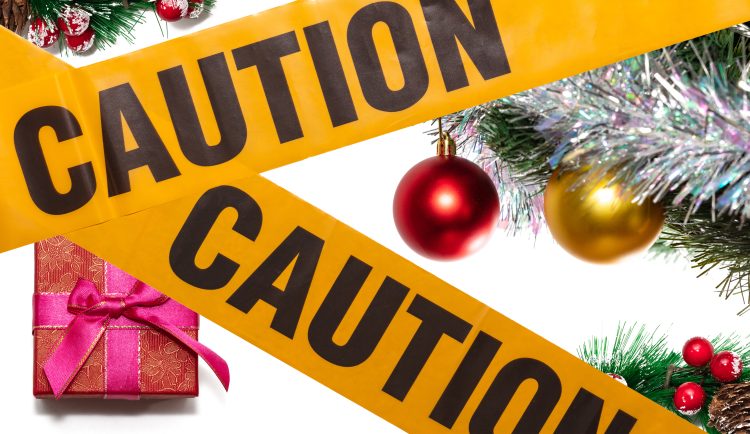Keeping in touch with homeowner clients from the past is a no-brainer. Maintaining relationships can often lead to new business and referrals. There are certain times of the year when communicating comes naturally, and the holiday season is probably No. 1. Getting back in touch through emails or notes can provide a subtle reminder that you want to stay connected, as well as providing useful information.
Instead of sending a generic Happy Holidays card, why not add helpful holiday safety tips?
“The holidays are a fun and festive time of rest and celebration,” said Courtney Klosterman, director of communications at Hippo Home Insurance. “However, risks and hazards become even more pronounced in busy and eventful times.” There are a wide variety of tips to help your homeowner clients prevent small issues from becoming big problems while celebrating the holiday season.
She explained that during the end-of-year holidays, it’s common to have lit candle lights decorating spaces, elaborate meals and decorations in place. However, these activities and flammable items increase the risk of fires if not handled with care. Here are other risk factors and actions to take, according to Hippo:
Overloaded electrical outlets. Plugging too many devices or electronic decorations into a single outlet can lead to overheating of outlets, wires and devices, potentially causing a fire. Spread out device usage and utilize surge protectors when necessary. Double-check the manufacturer’s electric specifications for devices and the maximum electrical output of outlets. Most electrical outlets in homes have a maximum 15 or 20 amperage load.
Flammable decorations near open flames. Holiday decorations, such as curtains, dried foliage or paper decorations, can catch fire easily if they are too close to open flames like candles or fireplaces. Pay attention to where you place decorations, ensuring they’re a safe distance from any flames or heat sources. Candles should be placed in stable holders on nonflammable surfaces, away from curtains, tablecloths and other combustible materials.
Chimney fires. The accumulation of creosote, a flammable byproduct of burnt organic material like wood, and other debris in the chimney can lead to chimney fires. These fires can spread downwards into the home in a matter of seconds.
“Ensure that a fire extinguisher is working by inspecting the pressure gauge which is typically next to the handle or lever,” said Klosterman. “Confirm that the pressure needle is in the green zone, meaning the extinguisher is ready for use. If it’s in the red zone, you need to service or replace it.”
Lights, wiring and outlets. Decorative lighting is a hallmark of the holiday season, but faulty wiring and damaged lights can lead to electrical fires. Many families reuse holiday lighting fixtures year after year, but wear and tear along the wiring can cause electrical sparks. Not all lights are multipurpose, and some for outside usage may not meet indoor safety standards. Holiday lights are susceptible to damage from storage, handling or exposure to the elements.
“Before hanging holiday lights, examine them for frayed wires,” advised Klosterman. “Make sure the bulbs are intact. Discard damaged lights and replace them with new, safe ones. Keep outdoor lighting wiring off the ground or encased in a conduit to prevent rodents from chewing on them. Distribute your holiday decorations across multiple outlets to prevent overloading.”
Christmas tree care. The Christmas tree is the highlight of many holiday festivities. Whether you opt for an aromatic evergreen or an artificial substitute, you’ll want to properly prepare and look after your tree. Dry trees are a glaring fire hazard, especially when decorated with multiple light fixtures.
“Natural Christmas trees have a limited life span and can dry out over time, particularly when exposed to indoor heating,” said Klosterman. “A dry tree is highly flammable. Some holiday decorations, such as candles especially, can generate heat. Placing them too close to the tree increases the risk of the tree drying out and potentially catching fire.”
If you opt for a natural tree, ensure it remains properly hydrated throughout the holiday season. Place freshly cut trees in a water-filled stand, and check the water level daily. A well-hydrated tree is less likely to dry out and become a fire risk.
Safely secure decorations. During the holidays, many people adorn their homes with festive decorations. However, they can drop and potentially cause injuries or damage to your home.
“Loose cords are common tripping hazards, and hanging ornaments can cause serious injuries if you don’t secure them properly,” noted Klosterman. “These loose cords and decorations can create tripping hazards in your home.”
Ensure all decorations are securely fastened and will not easily come loose. Use appropriate hooks, clips or hangers for different types of decorations. Wire hooks are sturdy enough for most hanging ornaments like wreaths. A fishing line has the strength to hold multiple ornaments at once. Use cable clips, tape or cord covers to secure cords and prevent them from creating tripping hazards. You can also use cord channels, plastic or rubber covers that conceal and protect cords. They come with adhesive for easy installation.
Remove child and pet hazards. “Families look forward to holiday festivities, and pets get to join in on the fun when everyone is excited,” said Klosterman. “However, holiday decor poses a threat to children and pets, and both tend to place all kinds of unsafe objects into their mouths.”
Small ornaments, tinsel and other decorative items can be tempting for children and pets to pick up and put in their mouths. Swallowing these items can lead to choking or digestive issues. Kids and pets may inadvertently knock over decorations, Christmas trees or fragile ornaments, potentially causing injury or damage to themselves or the home.
When decorating your home, opt for decorations that are less likely to shatter and don’t have small, easily digestible parts. Look for nontoxic and child-safe materials. Wooden and plastic decorations can endure many accidental falls. To prevent the tree from toppling over, use a sturdy tree stand and consider anchoring the tree to a wall or ceiling for added stability. Keep fragile ornaments and decorations higher up on the tree, out of reach of small hands and paws.
Anti-burglary upgrades. “While the holiday season is a time of rest and celebration, it is also a prime time for burglars to take advantage of festive distractions,” admitted Klosterman. “The holiday season often sees a rise in burglary rates as many homes contain valuable gifts and people are away at parties, gatherings or vacations. Unsecured and inviting homes expectant of guests make an ideal burglary and theft target.”
Many families travel for the holidays, leaving their homes vacant. Others who host holiday events may also become less guarded due to festivities. Valuable gifts are a prize for burglars, and the holidays are filled with them. Online shopping during the holidays entails packages with items of value. Package thieves take this opportunity to ramp up their processes. And homes are even more lit during the holidays, allowing for better outside visibility of a home’s interior. This gives burglars a clear view of valuables and an incentive to target a home.
Actions to take include, if fiscally possible, implementing a home security system consisting of alarms, cameras, motion sensors, automatic locks and detectors. Strengthen entry points by upgrading locks and deadbolts and by reinforcing doors and windows. To deter burglars, set a timer for your lights to automatically activate to convey the image of an occupied home.











